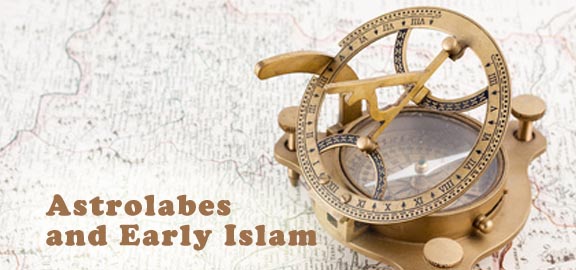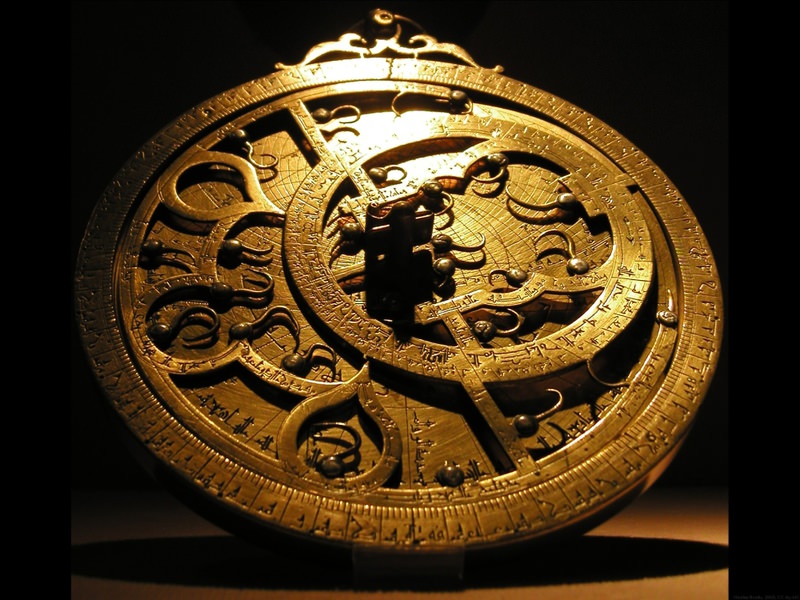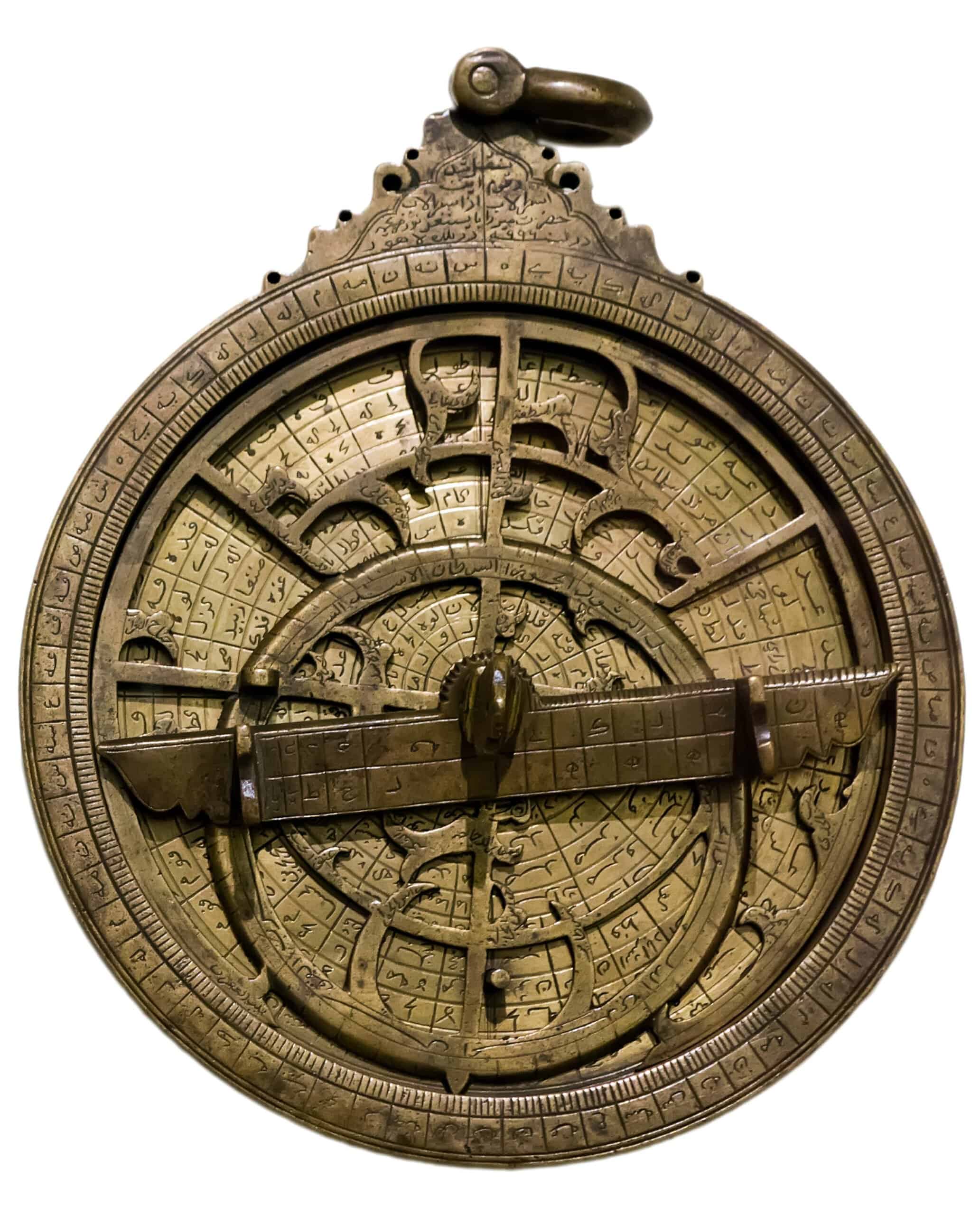Islamic Scholars Invented the Astrolabe Which Was Used to Determine
The alidade is attached to the back of the astrolabe. Eighth-century mathematician Muhammad al-Fazari is the first person credited with building the astrolabe in the Islamic world.

The Astrolabe The Swiss Army Knife Of Ancient Celestial Navigation
The astrolabe is an ancient astronomical tool used to measure the position of the sun and the stars as well as solve problems of time.

. The shadow square an instrument used to determine the linear height of an object in conjunction with the alidade for angular observations was also invented by. Although ancient Greek astronomers developed a version of the astrolabe the isntrument was highly developed in the Islamic world by the 9th century. These novel instruments invented by him have been preserved in the Museum of Madrid Spain Shipping instrument.
The mathematical background was established by Muslim astronomer Albatenius in his treatise Kitab az-Zij c. While their work was based on ancient sources from Greece Iran and India they updated methods for measuring and calculating the movement of heavenly bodies and. Astrolabes were first made around 150BC in Greece.
An astrolabe is an ancient instrument typically consisting of a series of metal plates spinning dials an eyepiece and other components. 920 AD which was translated into Latin by Plato Tiburtinus De Motu Stellarum. With an astrolabe astronomers could calculate the position of celestial objects the time of day or night the time of year the altitude of any object the latitude and much more.
The first universal astrolabe was invented by the Islamic scholar Abu Ishaq Ibrahim al-Zarqali. The mathematical background was established by Muslim astronomer Albatenius in his treatise Kitab az-Zij c. In the 8th century the famous Arab scientist and mathematician Muhammad ibn Ibrahim al-Fazari was the first Arab to construct an astrolabe.
An astrolabe is a scientific instrument used to work out the time of day using the sun or the stars. This is done using the alidade a kind of ruler on the back of the astrolabe which is used to work out information. Brass with silver inlay.
Universal Astrolabe 11th century Photo. It could also be used for astrological horoscopes and mathematical calculations. Volker Moehrke In the Middle Ages while Europeans were busy warring plundering and burning heretics at the stake Muslim scholars were inventing the.
Astrolabe made by Abd al-Karim al-Misrial-Madrabi brass with silver and copper inlay AH633 1236AD probably Mayyafariqin Turkey. 3 The astrolabe was very valuable in the Islamic religion. The alidade is used to take a stars altitude.
Essentially it was a. Muhammad Musa a great scholar of geography has the unique distinction of being the inventor of an instrument by which the earth could be measured. The astrolabe an analog computational device used in astronomy in the Islamic world shaped the future of navigation allowing sailors to determine their latitude.
Kitab suwar al-kawakib al-thabita Book of the Images of the Fixed Stars of al-Sufi. It helped determine the astronomically defined prayer times and was an aid in finding the direction to Mecca Islams holiest city. Apr 27 2014 - Not in the text.
Dating back to 1345-1355 CE this astrolabe is made of brass and was found in Spain where it was introduced by. Astrolabe is a device invented during the Greek age and is known as a multifunctional analogue computer used by astronomers and navigators. 920 AD which was translated into Latin by Plato Tiburtinus De Motu Stellarum.
In linking mathematics with fine craftsmanship coupled with excellent metallurgical knowledge she demonstrated her skills. During the medieval period scientists in the Islamic world made many contributions to the field of astronomy. He also invented the Astrolabe.
Bartolomeu Dias used the astrolabe to figure out the latitude of the Cape of Good Hope in 1488 because they were so far south that they lost Polaris Huth says. The Arab astronomer Al-Battani Albatenius on the other hand was the first scientist to establish the mathematical background of the astrolabes. Inventors of the astrolabe re-created the sky on the face of the instrument and marked it so that celestial bodies were easy to find.
The contributions of Islamic science and education are immense and obscured by the Wests achievements as well as contemporary Islams detachment from science Cooper says. Some academic works showed evidence which points out that the astrolabe made by Mariam could be used to precisely establish the mathematical positions of the stars and other celestial objects despite her not having a class in mathematics. Specifically of works by.
At the Museum of Islamic Art. Eighth-century mathematician Muhammad al-Fazari is the first person credited with building the astrolabe in the Islamic world.
Sciplanet The Arabs And The Advancement Of Astrolabes

The Astrolabe Through History Life As A Human

The Astrolabe Through History Life As A Human

Astrolabe Middle East 1291 Steampunk Clock Antiques
Masters Of The Astrolabe Google Arts Culture

Astronomy In The Medieval Islamic World Wikiwand

Guide Locator Ancient Artifacts Ancient History

Astrolabes And Early Islam Mariam Al Astrolabiya Al Ijliya Facts About The Muslims The Religion Of Islam Toll Free Hotline 1 877 Why Islam

Pin On Islamic Scientific Tools

Pdf The Astrolabe What It Is What It Is Not

Star Finders Astrolabes Muslim Heritagemuslim Heritage

Portable Cosmologies Muslim Heritagemuslim Heritage

Astrolabe Ancient History Ancient Artifacts Steampunk

The Islamic Legacy In Astronomy And Space Exploration Kolbe Times

Pin On Art Ancients Near Ancients Medieval

Www Mhs Ox Ac Uk Wp Content Themes Mhs 2013 Responsive Imu Media Php Irn X3d 37659 Antique Maps Astronomy Antiques



Comments
Post a Comment